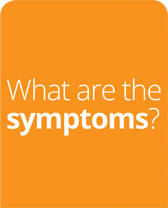The Symptoms of Crohn’s Disease
The symptoms of Crohn's disease (CD) vary according to its site, (i.e. small or large intestine) and severity. However, the following features occur in most cases.
Diarrhoea - sometimes, but not always, with blood.
Diarrhoea is an increase in the number of stools with a loose or watery consistency and a faecal weight greater than 200g in 24 hours. The urgent need to pass stools may be very distressing. Sometimes people experience an urgent desire to rush to the loo, but then pass nothing. This is called tenesmus.
The frequency and severity depends on whether or not the disease is active.
- Mild diarrhoea may produce four or fewer motions daily.
- Severe diarrhoea may produce six or more motions daily with visible blood.
Diarrhoea is a major feature of inflammatory bowel disease and is a defence mechanism of the body in response to inflammation and infection. The transit of faeces is speeded up in an effort to rid the gut of chemicals which cause inflammation. Symptomatic relief of diarrhoea with drugs such as codeine is not recommended when acute inflammation is present as such measures reduce the elimination of dangerous chemicals and thus may increase the damage these chemicals cause. This may lead to serious consequences such as thinning of the bowel wall and perforation. The desired outcome of treatment is to determine the cause of the inflammation, and to control it, thus relieving the diarrhoea. If diarrhoea is stopped artificially with drugs such as codeine, it further makes it very difficult to tell how effective the anti-inflammatory treatment is proving and may lead to a false impression of improvement.- Abdominal pain and tenderness over the intestine, often more severe in the right iliac fossa.
- Weight loss, and in children failure to grow.
- Fever.
- Tiredness.
- Sores and abscesses around the anus, which discharge. These may be the first signs of the disease in some patients.
Other symptoms not involving the intestine may occur:
- Sore mouth due to ulcers on the tongue or inside the cheek.
- Painful, inflamed eyes (uveitis).
- Painful, stiff or swollen joints, and also lower back-ache e.g. arthritis, ankylosing spondylitis.
- Sore, red lumps on the skin (erythema nodosum).
Symptom Scoring
Doctors have devised scoring systems based on the symptoms of a patient which enables them to assess progress in a fairly simple and straightforward way. The Crohn's disease activity index (CDAI) is complex and usually reserved for important research studies. The Harvey and Bradshaw index (HBI) is simpler and may be used in everyday practice.The HBI takes into account a number of symptom markers over the previous 24 hour period. Each symptom (apart from the actual number of liquid stools and complications) is scored - 0 if it is absent, 1 if it is mild 2 if it is moderate and 3 if it is severe. The symptoms involved are:
- General well-being.
- Number of liquid stools.
- Presence of abdominal masses.
- Abdominal pain.
- Any associated complications - each is scored as one point.
A symptom score of this type is not used in diagnosis - merely to assess progress. A score of 3 or less is taken as remission. A score of 6 or more signifies a relapse.

